-
Navy Glider Temperature and Salinity Profiles during eye passage.
Posted on October 11th, 2018 No commentsIn the previous post, Travis showed the plot of the CTD temperature section from the Navy glider operating just to the right of the path of Hurricane Michael. Here is our first look at the actual Temperature and Salinity profiles that go into that section plot.
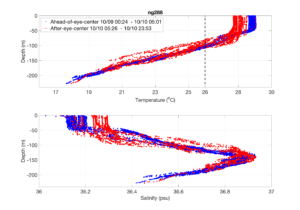
Above we see Maria’s plot of the temperature (top) and salinity (bottom) profiles reported by the Navy glider during the eye passage. Blue is ahead of eye center, red is after eye center. During this time we see a rapid temperature drop of about 1 C, and a deepening of the surface layer from about 50 m to about 90 m. For salinity, we see the salinity of the surface layer increase by about 0.1 psu.
-
Michael Gulf of Mexico SST anomaly and ocean response
Posted on October 11th, 2018 No comments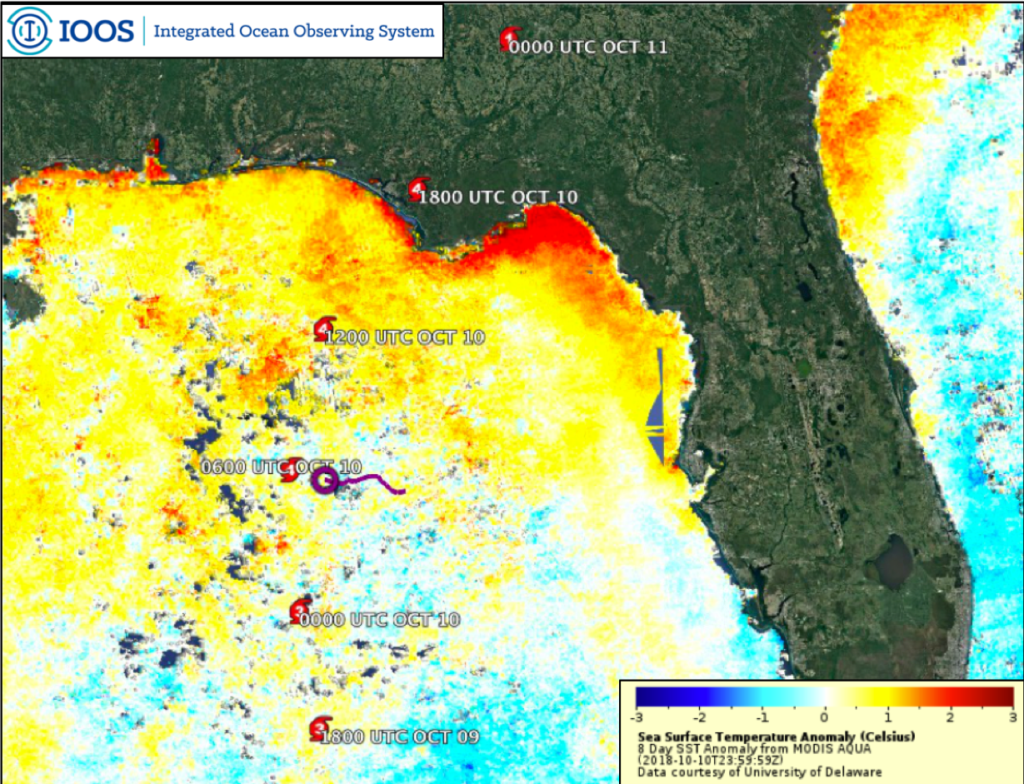
Micahel is now making its way through the Carolinas and into the Northeastern part of the country. It looks like it had a truly devastating impact of the Florida panhandle region coming ashore as a category 4, a few miles per hour shy of a category 5. Some of the rapid intensification is likely due to warm sea surface temperatures in the Gulf of Mexico. Above is a plot of the 8-day composite sea surface temperature anomaly after removal of the 15 year average for the same time period. This product is generated by the University of Delaware Ocean Remote sensing and Biogeography (ORB) Lab. Above average temperatures are clearly visible in the northern portion of the Gulf where the storm intensified.
Additionally, this image shows a glider track in purple for the US Navy Glider NG288, which we’ve been following for the past few blog posts. The system collected data throughout the storm, transmitted it to shore where the Navy made it available to IOOS for public release.
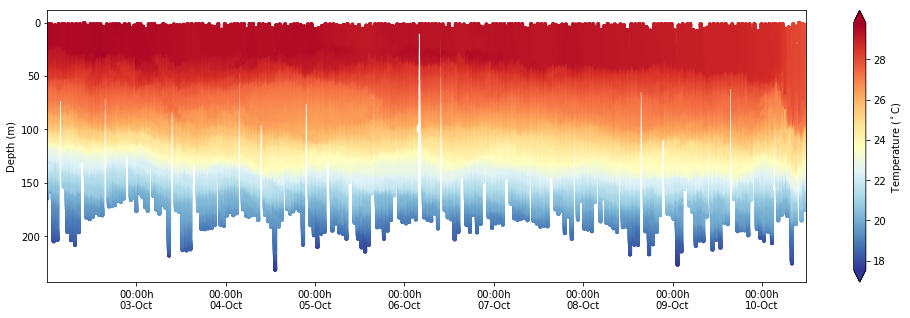
In the time and depth slice from NG288 it’s clear that surface layer was very warm, exceeding 28 Celsius down to about 50 meters ahead of the storm.This thick warm surface layer provided an ample pool of heat to maintain and intensify Michael as it approached land. On October 10th, as the storm passed over the glider location there is rapid mixing and deepening of the surface mixed layer from 50 meters down to almost 100 meters, but with very limited ocean cooling. This is an exciting dataset that we’ll be using for years to come to understand rapid intensification of hurricanes in the Gulf of Mexico.
-
Back to Sri Lanka
Posted on October 11th, 2018 No comments
Waypoint is to the southwest, but RU29 is moving northeast, about 180 degrees from the waypoint. Ru29 is about 140 nautical miles south of Galle, the southern most port and the location of our recovery vessel. the red semi-circle is the 120 nautical mile circle from Galle. At 10 knots, this is a 12 hour boat ride from Galle.
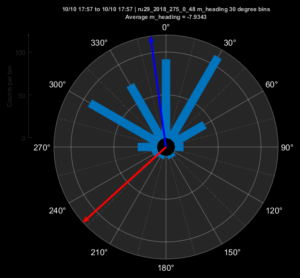
Heading compass rose. Direction to waypoint is in red, to southwest. Histogram of observed heading in 30 degree increments in light blue. Average heading is dark blue arrow, which is almost directly north, or 135 degrees to the right of the commanded heading. But we are not heading north. We are heading northeast. There must be some eastward current.
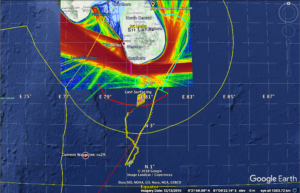
Checking traffic, the busy shipping lane extends around the southern side of Sri Lanka a distance of 40 nautical miles offshore. We don’t want to come any closer than this.
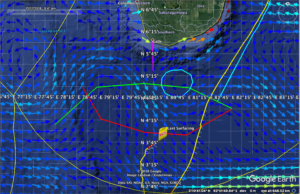
Now we zoom in and look at the currents. First Copernicus. Currents at the glider are to the southeast, so they have an eastward component. Between RU29 and Galle there is a wavy current that runs west to east. There is a low velocity region half way between Ru29 and Sri Lanka circled in cyan. The currents are counterclockwise around this low current region. So a counterclockwise eddy in Copernicus.
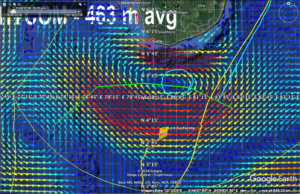
Hycom has an eddy in the exact same place as Copernicus, as seen by the cyan circle. But the circulation around the eddy in hycom is clockwise. The currents at the glider are strong and to the northwest. But the glider needs a current with an eastward component to produce the observed progress to northeast.
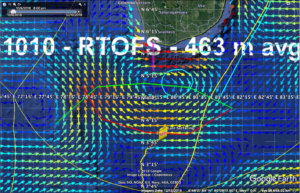
RTOFS has similar results to hycom, with a clockwise eddy between RU29 and Sri Lanka, and strong currents to northwest at the glider.
Looks like the Copernicus model wins today in this location. That means we should move the waypoint to direct our commanded heading to be more towards the south. A waypoint to the south would give us an actual glider flight direction 135 degrees to the right, or towards the northwest. Combine this with the eastward or southeastward currents, and we may get the east-west components to cancel each other, enabling us to make more progress directly to the north.
-
Hurricane Michael cloud tops
Posted on October 10th, 2018 No comments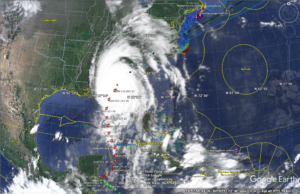
Above is our usual cloud top image showing the size of Hurricane Michael after making landfall today in Florida. Michael is forecast to take an inland route across the southeast states and cross the Mid Atlantic Bight on its way back out to sea.
-
Hurricane Michael glider model comparisons for October 9th
Posted on October 10th, 2018 No comments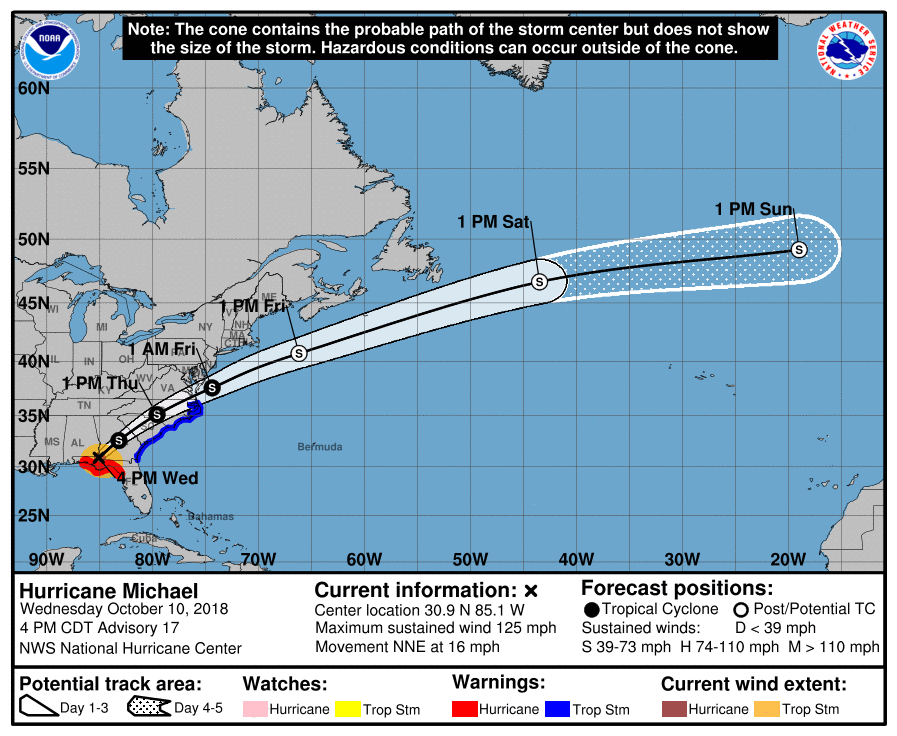
According to the National Hurricane Center Michael has made landfall in Florida as a Category 4 Hurricane with winds just below Category 5 levels.
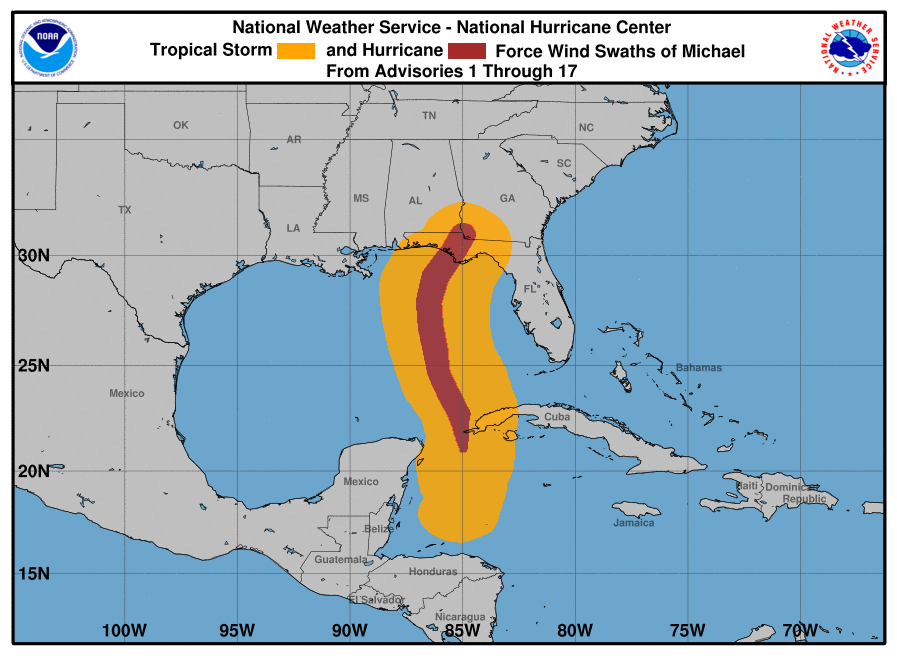
There’s an approximately 500 km wide swath of hurricane and tropical storm force winds across the eastern Gulf of Mexico.
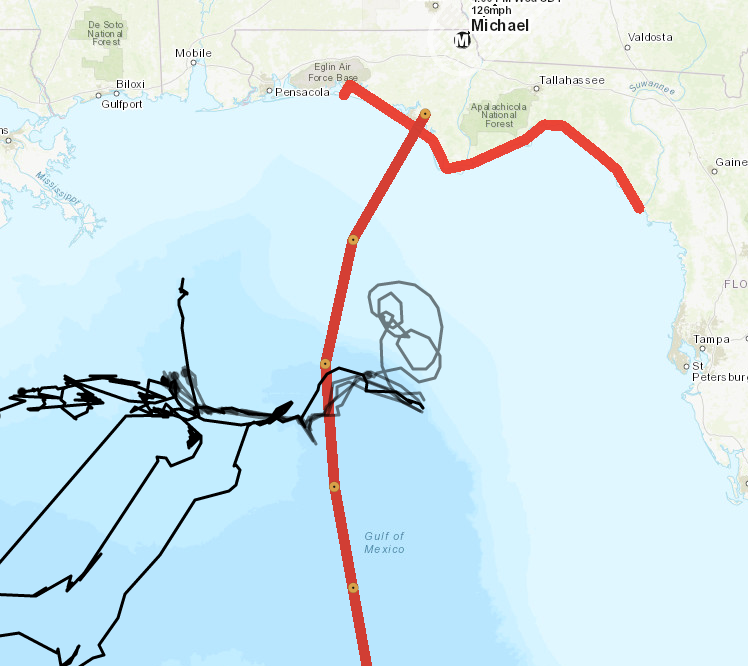
Just prior to landfall, the storm’s eye passed within about 50 kilometers of Navy Glider NG288’s most recent reported location.
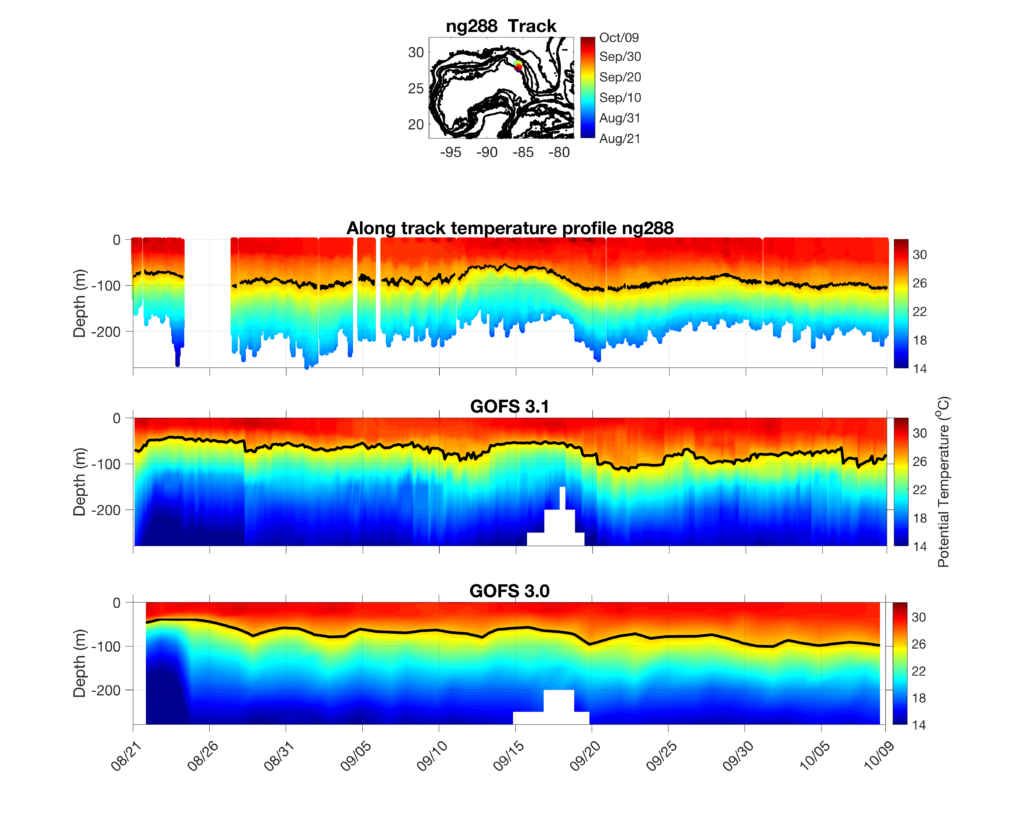
Above are Cross-sections of temperature from (top) Glider NG288, (middle) the Navy HYCOM Global Ocean Forecasting System 3.1, and (bottom) Navy HYCOM Global Ocean Forecasting System 3.0 run by the Navy Research Laboratory. The black contour shows the position of the 26 degrees Celsius isotherm, which is commonly used to calculate ocean heat content for hurricane intensity purposes.
At a glance the models have similar surface temperatures to the glider observations throughout the deployment, but the 26 degree Celsius isotherm in both GOFS 3.0 and 3.1 appear to be slightly shallower than the observed position.
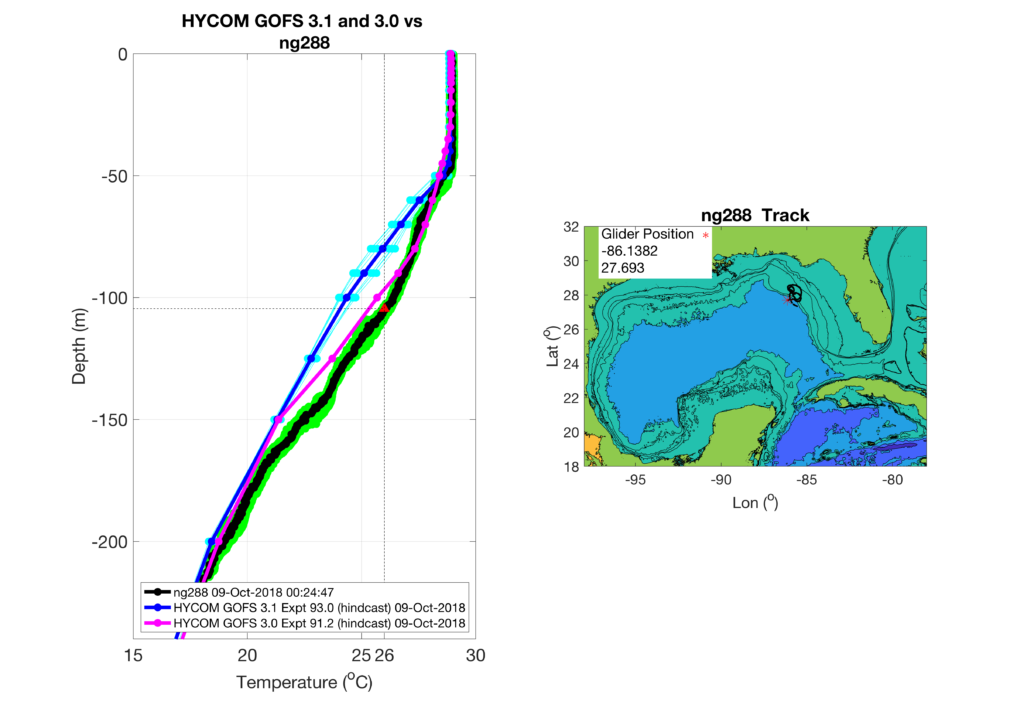
Next we zoom in to the last days profile comparisons before Michaels passage. The lines and colors are defined as in the previous post, but now we’ve added a vertical line and red triangle indicating the 26 degree Celisus temperature its depth in the glider observations. The depth of the mixed layer at 50 meters is well represented by GOFS 3.1, while GOFS 3.0 does a better job of matching the observed temperature profiles below the mixed layer.
-
Navy Glider Model Comparisons for Hurricane Michael
Posted on October 8th, 2018 No comments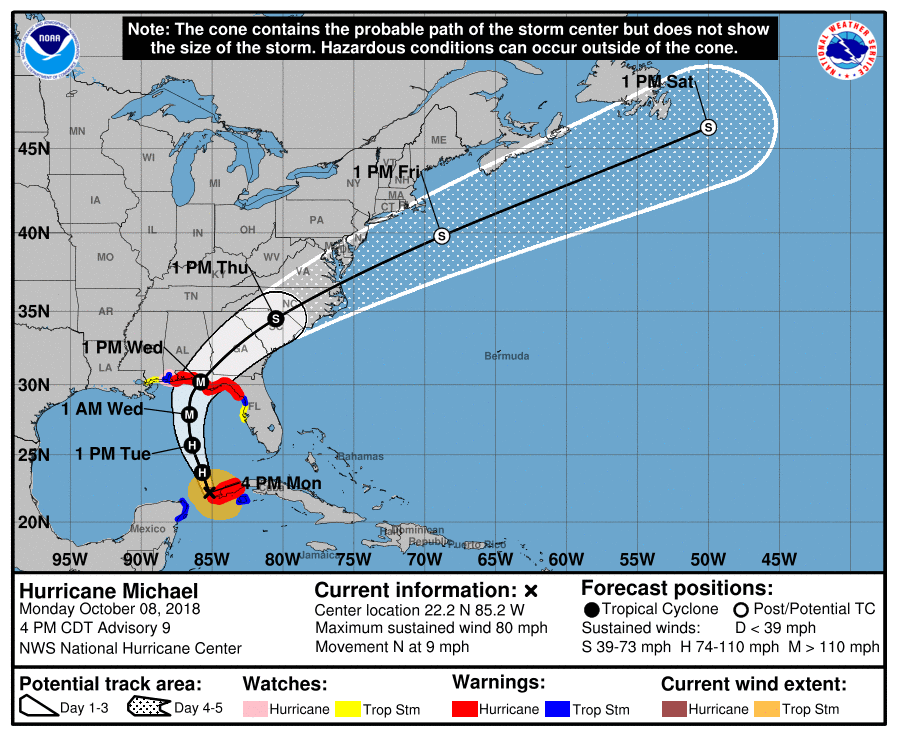
The Atlantic Hurricane season is not over yet. Hurricane Michael has recently spun up in the Caribbean Sea and is making its way into the Gulf of Mexico. There are still a number of gliders in the east coast, Caribbean, and Gulf of Mexico picket line out there. Navy Glider NG288 is positioned just to the right of Michael’s predicted track, where winds, waves, and ocean mixing are likely to be the highest. A plot of the NHC storm track and glider track (in black) is shown below from the MARACOOS Oceansmap Data Portal
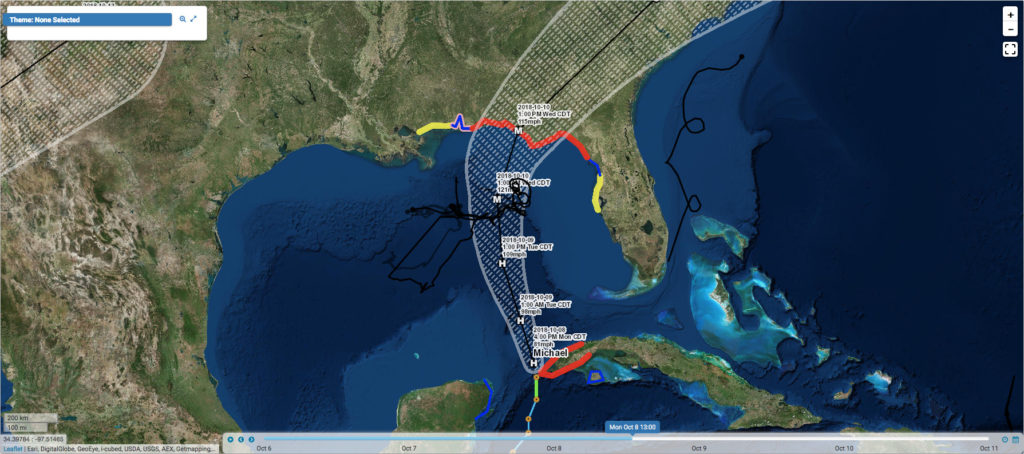
Maria, our IOOS research analyst, has generated the usual glider data/model comparison profiles for the last day from Navy HYCOM GOFS 3.0 and 3.1.
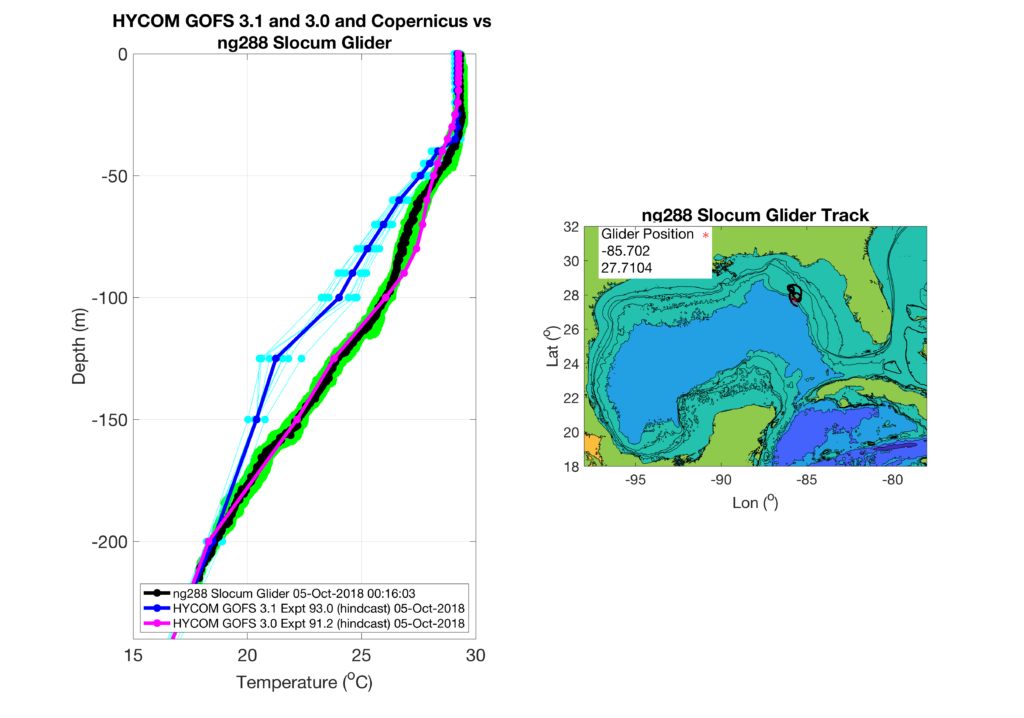
In the left panel: individual glider data profiles are shown in green with the daily mean in black, GOFS 3.0 only archives daily and is plotted in magenta, and GOFS 3.1 profiles are every 3 hours and plotted in light blue with the daily average in dark blue. In the upper 30 meters both GOFS 3.0 and 3.1 are in good agreement with glider observations with temperatures all near 29 Celsius. Below 30 meters depth the models diverge, with GOFS 3.0 following the glider profiles closely throughout the water column. GOFS 3.1 remains a few degrees cooler than the glider and 3.0 until about 200 meters depth. The heat content, defined as the depth integrated heat above the 26 degree isotherm, for GOFS 3.1 is going to be lower than the glider or GOFS 3.0.
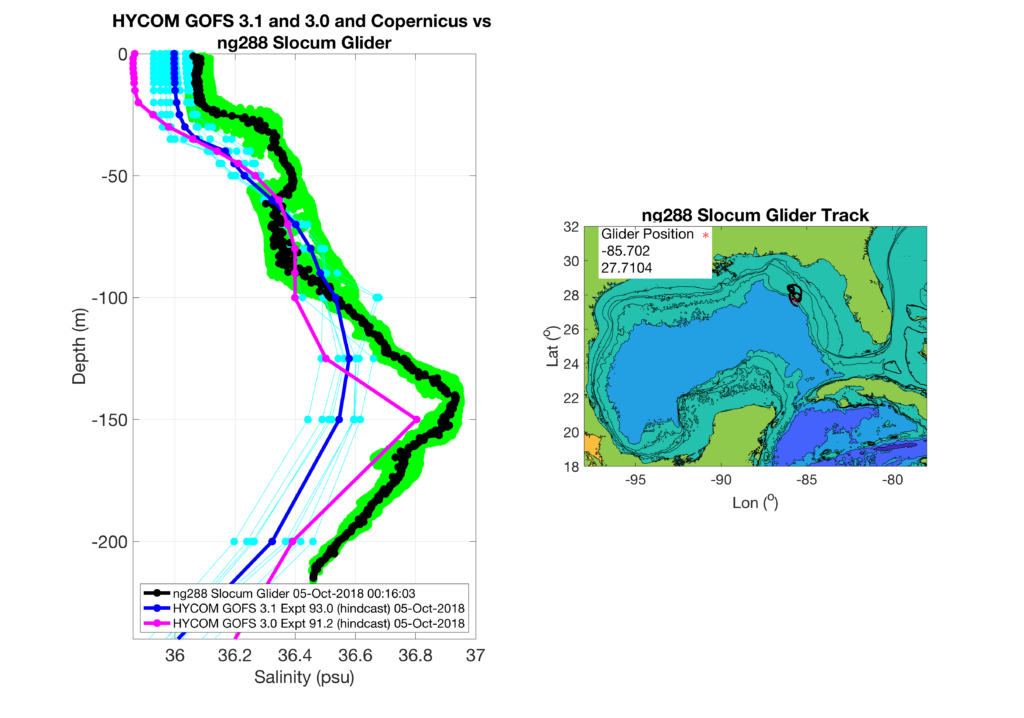
Both models are fresher than the observed salinity profiles throughout the water column, with GOFS 3.1 being closer to observations in the surface, and GOFS 3.0 closer near the salinity maximum at ~150 meters depth.
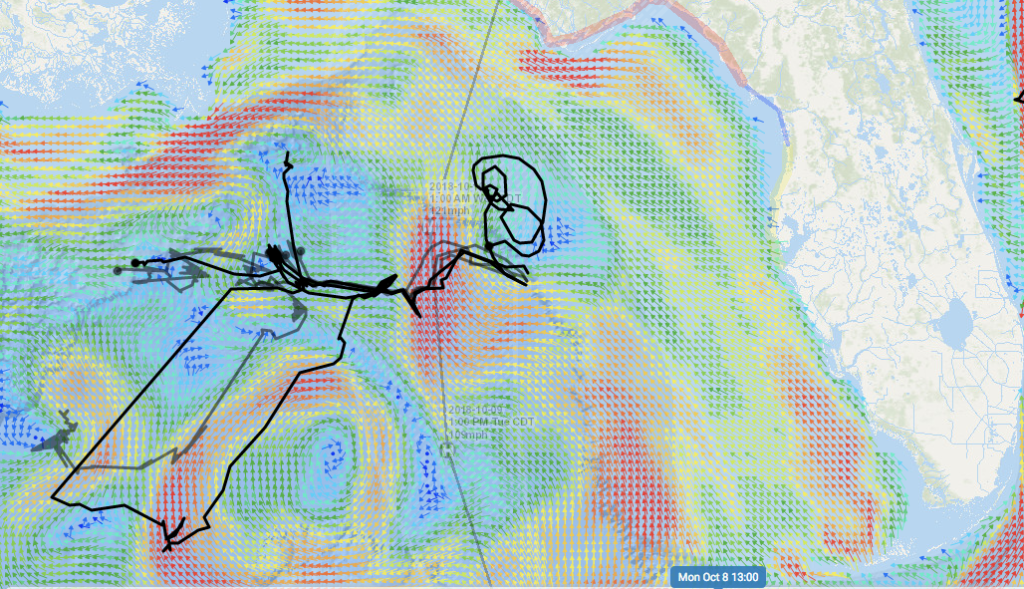
A snapshot of surface currents from Navy HYCOM in MARACOOS Oceansmap shows that a warm core loop current eddy is located just to the west of the storms predicted position at 1:00 PM CDT Tuesday October 9th. The glider is located in a frontal region near the storms predicted position at 1:00 AM CDT Wednesday October 10th, with slow currents to its east and fast northward currents to its west. The uncertainty in model data comparisons may be related to the placement of these features in the different models, and will require further investigation.



